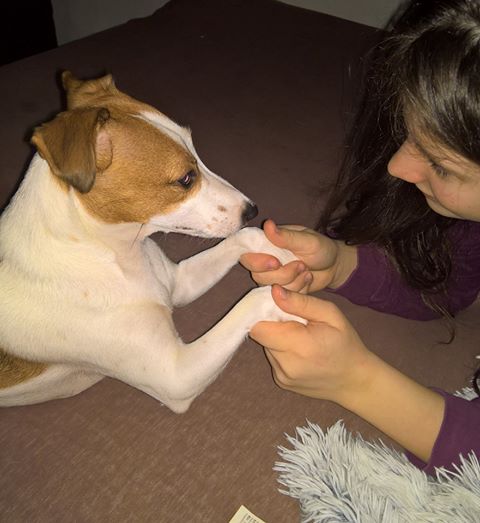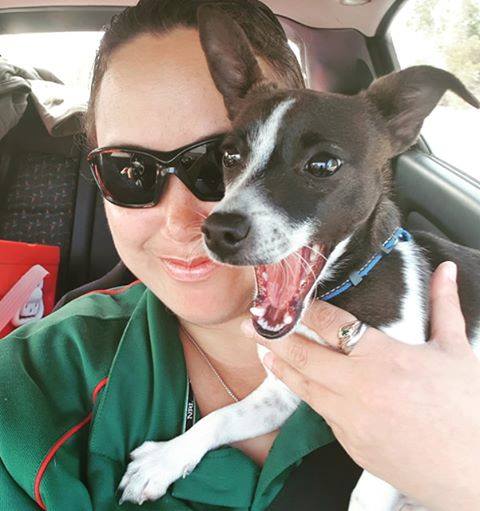Table of Contents
Dogs have been humanity’s best pal for at least 15,000 years. Some believe it might even be as much as 36,000 years.
*This post may contain affiliate links. As an Amazon Associate we earn from qualifying purchases.
Throughout that time, dogs have been our companions, our protectors, our hunting partners, and more. Today they’re still our companions, but their roles have branched out to include search and rescue, service work different kinds of therapy, and other vital functions.

It’s impossible for two species to live and work together so intimately, for such a long time without changing one another, intentionally and otherwise. And, as science has explored the bond between people and dogs, researchers have come up with some pretty amazing findings.
Such as?
Check it out.
They Really Do Know What We’re Thinking
Have you ever looked into your dog’s eyes and just known that they understand? Does your dog seem to know when you’re happy, sad, or stressed, and respond accordingly — better than some people do, and without your having to say a word?
Some people may scoff, but according to science, you’re right.

It’s not magic. The fact is, dogs communicate nonverbally with each other — and with us — all the time. It’s no surprise, then, that they’re masters of picking up on our nonverbal communication — even when we don’t know what, or even that, we’re communicating.
In fact, some dogs are so adept at reading our feelings and intentions — even without our knowing ourselves — that their ability might be interpreted as psychic powers. Or, interestingly, as prodigious mathematical abilities.
Your Dog Knows a Bad Person When They See One
A 2017 study published in Neuroscience and Behavioural Reviews shows that dogs and different kinds of monkeys can tell when someone is being nasty to another person. On top of that, they will judge the unhelpful person unworthy and show a distinct preference for the “victim” of unkind behavior.
(Anecdotally, my own dog will always take my son’s side when we play-fight, even if my son started it!)

A lot of people say that if your dog doesn’t like someone, you should listen to your dog.
According to science, there’s something to that. Dogs can, after all, pick up on signs of aggression that humans might miss. For example,
So if your dog suddenly seems alert to trouble, it’s best to pay attention.
They Want to Help
When we’re feeling something strongly, we may or may not say anything. But we’re communicating all the same. We hold our bodies in different postures, we emit different smells when we’re angry or afraid, and we have lots of other little behaviors that give us away.
Dogs are adept at reading those signals. And if something’s wrong, they want to help.

A 2017 study by Emily Sanford showed that not only do dogs display empathy with humans as well as other dogs, but they also respond to human verbal and nonverbal distress signals by trying to help. They do this by relying on social cues that they have learned as a result of the long, intimate history between our two species.
This ability is what makes (some) dogs such excellent therapy animals. Not only do they observe and understand, but they want to help, too!
They Can Sniff Out Diseases
It’s true.
Dogs’ powerful abilities of observation are second only to their amazing noses.
According to Dr. Ann Hohenhaus, dogs can differentiate between up to 100,000 different smells — that’s 10 to 25 times more than humans can identify.

Most interestingly, dogs are able to
Some other diseases dogs can sniff out include narcolepsy and Parkinson’s Disease. They can also detect when a migraine is about to come on, as well as when a person may be experiencing low blood sugar.
They Can See Ghosts
Well, if you believe in that sort of thing.
Even if you don’t, it’s absolutely true that dogs can see and hear things that we can’t.
Dogs are one of the animals, for example, that can see in
Their hearing is also much more powerful than ours. They can hear things in a frequency range that is nearly four times greater than the range of human hearing. And they can hear things up to four times farther away than humans can.

So if your dog is barking at something you can’t hear, and staring at something you can’t see, it’s tempting to think it might be a spirit. And if ghosts appear in ultraviolet, it’s possible!
But it could just as easily be natural phenomena that our dull human senses aren’t able to pick up.
They Can Learn Sign Language
Most trained dogs can understand around 160 human words. Canine super geniuses like border collies can retain around 200.

But dogs’ understanding isn’t limited to verbal commands. Dogs can also learn hand signals. And, when it comes to deaf dogs, they can learn just as many hand signs as hearing dogs can learn spoken words.
In fact, many people communicate with their deaf dogs by using signs from American Sign language or other sign language systems.
Since Jack Russell Terriers are susceptible to deafness, and all dogs can lose their hearing due to age, illness, or injury, you might consider incorporating some hand signals into your own canine communications.
They Improve Your Health
Having a dog is good for you. Science has proven it in many ways. In fact, one study has shown that dog ownership reduces your chances of dying from heart disease by 23 percent. And study participants who owned dogs were 20 percent less likely to die from any cause during the 12-year study.
Why is that? You might ask.
First, dog owners in the study responded better to stress. Dog owners also tend to have lower blood pressure and lower cholesterol.

Other studies have shown that dog ownership can reduce isolation and depression — as well as the problems that can stem from them. Dog owners in one study had an easier time meeting and connecting with people in their neighborhoods. They also tended to regard the people they met as friends more often, when they met through their dogs.
There’s also the fact that people who have dogs tend to get more exercise. Anyone who loves a Jack Russell knows that if they don’t get their walkies, or their ball-chasing, or their agility training, or their doggy Yoga, they’re going to be miserable. And they’re going to make you miserable. The Jack Russell is no dog for a couch potato. If you’ve got a Jack, you’re going to get your exercise.
They Really Do Smile
But we didn’t need to tell you that.
Dogs have emotional lives. Neuroscientists have proven it. And one of those emotions is happiness.
And yes, when you see that doggy grin, it means exactly what you think it does. Your dog is feeling happy, relaxed, and they’re smiling.

It’s not the same as a primate smile, which evolved from a fang-flashing gesture. The primate smile began as an aggressive gesture. Then, gradually, it became something primates did to show submission. Now, in modern humans, it’s a friendly gesture.
A dog smile is more a combination of the relaxation of facial muscles with the particular shape of your dog’s face. But even though the origin of the expression is different, in the end, it has the same meaning. Your dog’s smile really is a smile.
Their Tail is Pretty Amazing, Too
We already know that the nose is one of your dog’s most amazing features. But what about the other end?
That’s right — the tail. Well, it turns out, the tail has a tale all its own.
The tail is an extension of your dog’s spine: between six and twenty-three vertebrae surrounded by muscle.

It’s also a complex communications device. Your dog doesn’t just wag when they’re happy. Depending on the direction of the wag, the speed, and how high your dog is holding their tail when they wag it, a wag can have a lot of different meanings.
It could mean they’re happy, cautious, or even aggressive. Your dog may also tuck their tail if they’re feeling frightened.
And when there’s no one else around, they don’t wag at all. Wagging is a social, communicative gesture.
The tail also helps your dog to balance. And it can also spread your dog’s scent around, so other dogs can get to know your dog better.
Yes, the tail is an amazing thing. Don’t you wish you had one?
They Have Many Ways of Saying “I Love You.”
Dogs are “speaking” to us all the time, but a lot of it goes right past us. And that’s a

How do our dogs tell us they love us? How do they reaffirm pack bonds? How do they tell us how happy they are in our company, and how we make them feel comfortable and protected?
In a lot of ways, such as:
- sleeping on their backs
- staring with a relaxed posture and wagging tail
- blinking
- that adorable head tilt
- sniffing in embarrassing places
Our dogs are trying to communicate with us all the time. Are you listening?
Our Amazing Friends
Our dogs are more than pets.
The bond between dogs and humans goes back tens of thousands of years. They have been part of our societies, and we’ve been like members of their packs. Our species have grown together, our lives intertwined, and it’s changed us both.

Featured Image: CC0 by X Posid, via Public Domain Pictures

